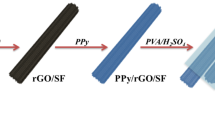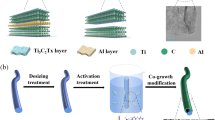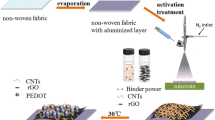Abstract
Flexible carbon electrode with high performance from silk fabric was fabricated by a simple approach. Silk fabric was uniformly dyed with heteroatom-enriched dye molecules by a traditional dyeing process, followed by direct pyrolysis. The as-prepared heteroatom-co-doped carbonized silk fabric exhibits a significantly improved electrochemical performance with the specific capacitance of 255.95 F g−1 at the scan rate of 2 mV s−1 using 1 M Na2SO4 electrolyte, a wide operation voltage window as well as a good cycling life stability (8% capacitance loss over 5000 cycles). The excellent capacitive performance can be attributed to the multiple synergistic effects between the double-layer capacitance (hierarchical porosity, good wettability and conductivity) and the extra pseudocapacitance (N, O and S heteroatom co-doping). Moreover, the carbonized dyed silk fabric possesses wearability and lightweight. Importantly, the convenient approach can provide industrial-grade production of heteroatom-co-doped silk fabric-based carbon electrode materials for applications in flexible energy storage devices.





Similar content being viewed by others
References
Wei C, Xu Q, Chen Z, Rao W, Fan L, Yuan Y, Bai Z, Xu J (2017) An all-solid-state yarn supercapacitor using cotton yarn electrodes coated with polypyrrole nanotubes. Carbohydr Polym 169:50–57
Ye X, Zhou Q, Jia C, Tang Z, Wan Z, Wu X (2016) A knittable fibriform supercapacitor based on natural cotton thread coated with graphene and carbon nanoparticles. Electrochim Acta 206:155–164
Zhao J, Li X, Cai ZS, Ge FY (2017) A flexible carbon electrode based on traditional cotton woven fabrics with excellent capacitance. J Mater Sci 52(3):1–7. https://doi.org/10.1007/s10853-017-1161-z
Zhang H, Yan Q, Lu Z (2016) Fully-printed ultra-flexible supercapacitor supported by a single-textile substrate. ACS Appl Mater Interfaces 8(47):32317–32323
Chen J, Wei H, Fu N, Chen H, Lan G, Lin H, Han S (2018) Facile synthesis of nitrogen-containing porous carbon as electrode materials for superior-performance electrical double-layer capacitors. J Mater Sci 53(3):2137–2148. https://doi.org/10.1007/s10853-017-1664-7
Feng J-X, Li Q, Lu X-F, Tong Y-X, Li G-R (2014) Flexible symmetrical planar supercapacitors based on multi-layered MnO2/Ni/graphite/paper electrodes with high-efficient electrochemical energy storage. J Mater Chem A 2(9):2985–2992
Singu DC, Joseph B, Velmurugan V, Ravuri S, Grace AN (2017) Combustion synthesis of graphene from waste paper for high performance supercapacitor electrodes. Int J Nanosci 17:1760023
Suganya N, Jaisankar V, Sivakumar EKT (2017) Conducting polymeric hydrogel electrolyte based on carboxymethylcellulose and polyacrylamide/polyaniline for supercapacitor applications. Int J Nanosci 17:1760003
Shi S, Xu C, Yang C, Chen Y, Liu J, Kang F (2013) Flexible asymmetric supercapacitors based on ultrathin two-dimensional nanosheets with outstanding electrochemical performance and aesthetic property. Sci Rep 3(6150):2598
Huang Y, Peng L, Liu Y, Zhao G, Chen JY, Yu G (2016) Biobased nano porous active carbon fibers for high-performance supercapacitors. ACS Appl Mater Interfaces 8(24):15205–15215
Choi C, Lee JM, Kim SH, Kim SJ, Di J, Baughman RH (2016) Twistable and stretchable sandwich structured fiber for wearable sensors and supercapacitors. Nano Lett 16(12):7677–7684
Bao L, Li X (2012) Towards textile energy storage from cotton T-shirts. Advanced materials 24(24):3246–3252
He S, Chen W (2015) Application of biomass-derived flexible carbon cloth coated with MnO2 nanosheets in supercapacitors. J Power Sour 294:150–158
Liang Y, Wu D, Fu R (2013) Carbon microfibers with hierarchical porous structure from electrospun fiber-like natural biopolymer. Sci Rep 3(7):1119
Xue J, Zhao Y, Cheng H, Hu C, Hu Y, Meng Y, Shao H, Zhang Z, Qu L (2013) An all-cotton-derived, arbitrarily foldable, high-rate, electrochemical supercapacitor. Phys Chem Chem Phys 15(21):8042–8045
Zhu Yh, Yuan S, Bao D, Yb Yin, Hx Zhong, Xb Zhang, Jm Yan, Jiang Q (2017) Decorating waste cloth via industrial wastewater for tube-type flexible and wearable sodium-ion batteries. Adv Mater 29:1603719
Jost K, Stenger D, Perez CR, McDonough JK, Lian K, Gogotsi Y, Dion G (2013) Knitted and screen printed carbon-fiber supercapacitors for applications in wearable electronics. Energy Environ Sci 6(9):2698–2705
Zhou DD, Li WY, Dong XL, Wang YG, Wang CX, Xia YY (2013) A nitrogen-doped ordered mesoporous carbon nanofiber array for supercapacitors. J Mater Chem A 1(29):8488–8496
Chen LF, Zhang XD, Liang HW, Kong M, Guan QF, Chen P, Wu ZY, Yu SH (2012) Synthesis of nitrogen-doped porous carbon nanofibers as an efficient electrode material for supercapacitors. ACS Nano 6(8):7092–7102
Razmjooei F, Singh K, Kang TH, Chaudhari N, Yuan J, Yu JS (2017) Urine to highly porous heteroatom-doped carbons for supercapacitor: a value added journey for human waste. Sci Rep 7(1):10910
Tang C, Liu Y, Yang D, Yang M, Li H (2017) Oxygen and nitrogen co-doped porous carbons with finely-layered schistose structure for high-rate-performance supercapacitors. Carbon 122:538–546
Uddin K, Hossain S (2010) A comparitive study on silk dyeing with acid dye and reactive dye. Int J Eng Technol 10(6):21–26
Ma D, Ma Y, Chen Z, Hu A (2017) A silk fabric derived carbon fibre net for transparent capacitive touch pads and all-solid supercapacitors. J Mater Chem A 5(39):20608–20614
Wang C, Li X, Gao E, Jian M, Xia K, Wang Q, Xu Z, Ren T, Zhang Y (2016) Wearable strain sensors: carbonized silk fabric for ultrastretchable, highly sensitive, and wearable strain sensors (Adv. Mater. 31/2016). Adv Mater 28(31):6640–6648
Genovese M, Jiang J, Lian K, Holm N (2015) High capacitive performance of exfoliated biochar nanosheets from biomass waste corn cob. J Mater Chem A 3(6):2903–2913
Hou J, Cao C, Idrees F, Ma X (2015) Hierarchical porous nitrogen-doped carbon nanosheets derived from silk for ultrahigh-capacity battery anodes and supercapacitors. ACS Nano 9(3):2556–2564
Alabadi A, Yang X, Dong Z, Li Z, Tan B (2014) Nitrogen-doped activated carbons derived from a co-polymer for high supercapacitor performance. J Mater Chem A 2(30):11697–11705
Xia K, Gao Q, Jiang J, Hu J (2008) Hierarchical porous carbons with controlled micropores and mesopores for supercapacitor electrode materials. Carbon 46(13):1718–1726
Li X, Wang J, Zhao Y, Ge F, Komarneni S, Cai Z (2016) Wearable solid-state supercapacitors operating at high working voltage with a flexible nanocomposite electrode. ACS Appl Mater Interfaces 8(39):25905–25914
Liu R, Pan L, Wan L, Wu D (2015) An evaporation-induced tri-consistent assembly route towards nitrogen-doped carbon microfibers with ordered mesopores for high performance supercapacitors. Phys Chem Chem Phys 17(6):4724–4729
Kotal M, Kim J, Kim KJ, Oh IK (2016) Sulfur and nitrogen co-doped graphene electrodes for high-performance ionic artificial muscles. Adv Mater 28(8):1610–1615
Xie Q, Bao R, Xie C, Zheng A, Wu S, Zhang Y, Zhang R, Zhao P (2016) Core-shell N-doped active carbon fiber@ graphene composites for aqueous symmetric supercapacitors with high-energy and high-power density. J Power Sources 317:133–142
Acknowledgements
This work was supported by the National Natural Science Foundation of China (No. 51203018).
Author information
Authors and Affiliations
Corresponding author
Electronic supplementary material
Below is the link to the electronic supplementary material.
Rights and permissions
About this article
Cite this article
Li, X., Zhao, J., Cai, Z. et al. A dyeing-induced heteroatom-co-doped route toward flexible carbon electrode derived from silk fabric. J Mater Sci 53, 7735–7743 (2018). https://doi.org/10.1007/s10853-018-2100-3
Received:
Accepted:
Published:
Issue Date:
DOI: https://doi.org/10.1007/s10853-018-2100-3




